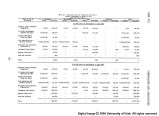| OCR Text |
Show SUMMARY This report summarizes the results of comprehensive investigations for the formulation of proposed plans to provide a "broad guide to the "best use, or combination of uses, of water and related land resources to meet foreseeable needs. It provides appraisals of natural resources and their geographic distribution, makes projections of future requirements, defines problems and needs, and presents a framework program and alternatives thereto to serve as a general guide for resource development and conserva- tion for the years 1980, 2000, and 2020. The Upper Colorado Region comprises the drainage of the Colorado River above Lee Ferry, Arizona, and the Great Divide Basin in south-central Wyoming. The region includes parts of Arizona, Colorado, New Mexico, Utah, and Wyoming and totals 113*^-96 square miles in area. Nearly two-thirds of the land is in public ownership. The region is and probably will remain largely an exporter of raw and partially processed materials and other resources, including water and an importer of finished products. A majority of the available water is now committed to downstream delivery and transmountain diversion. Agriculture is livestock oriented, with beef cattle being the major product. They are produced on the range- and irrigated-farm base and mostly marketed outside the region. About 87 percent of the projected production of electrical energy will be exported. The bulk of mineral development will be for petroleum, uranium, coal, molybdenum, and trona production. The 1965 population of 366,000 is projected to almost double by 2020. This includes the hydrologic portion of Arizona. Outstanding opportunities are available for year-round recreational activities. A great number of visitors from adjoining regions and through- out the United States enjoy the fishing, hunting, skiing, camping, and other outdoor activities within the region. The 1965 level of water and related land utilization, management, and development was used as the base year for planning. The total water supply? which assumes no depletions by man's activities, averages lU.87 million, acre-feet annually based upon the period 191^-65. On-site depletions plus the evaporation from reservoirs on the main stem of the Colorado River for 1965 normalized conditions were 3.^5 million acre-feet. Irrigation and. associated depletions accounted for 62 percent of the 1965 use, main-stem reservoir evaporation 19 percent, export to adjacent regions 15 percent, and the remaining k percent was used for all other purposes. The Office of Business Economics and Economic Research Service (OBERS) March 1968, projections were modified to better fit the situation in tb.e |













































































































































